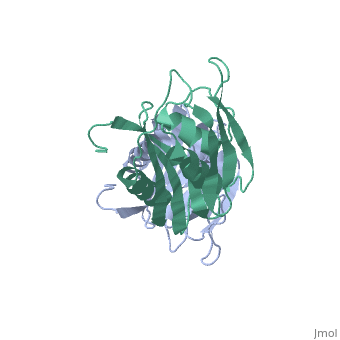1pkp
From Proteopedia
(Difference between revisions)
| Line 3: | Line 3: | ||
<StructureSection load='1pkp' size='340' side='right'caption='[[1pkp]], [[Resolution|resolution]] 2.80Å' scene=''> | <StructureSection load='1pkp' size='340' side='right'caption='[[1pkp]], [[Resolution|resolution]] 2.80Å' scene=''> | ||
== Structural highlights == | == Structural highlights == | ||
| - | <table><tr><td colspan='2'>[[1pkp]] is a 1 chain structure with sequence from [ | + | <table><tr><td colspan='2'>[[1pkp]] is a 1 chain structure with sequence from [https://en.wikipedia.org/wiki/Geobacillus_stearothermophilus Geobacillus stearothermophilus]. Full crystallographic information is available from [http://oca.weizmann.ac.il/oca-bin/ocashort?id=1PKP OCA]. For a <b>guided tour on the structure components</b> use [https://proteopedia.org/fgij/fg.htm?mol=1PKP FirstGlance]. <br> |
| - | </td></tr><tr id=' | + | </td></tr><tr id='method'><td class="sblockLbl"><b>[[Empirical_models|Method:]]</b></td><td class="sblockDat" id="methodDat">X-ray diffraction, [[Resolution|Resolution]] 2.8Å</td></tr> |
| - | <tr id='resources'><td class="sblockLbl"><b>Resources:</b></td><td class="sblockDat"><span class='plainlinks'>[ | + | <tr id='resources'><td class="sblockLbl"><b>Resources:</b></td><td class="sblockDat"><span class='plainlinks'>[https://proteopedia.org/fgij/fg.htm?mol=1pkp FirstGlance], [http://oca.weizmann.ac.il/oca-bin/ocaids?id=1pkp OCA], [https://pdbe.org/1pkp PDBe], [https://www.rcsb.org/pdb/explore.do?structureId=1pkp RCSB], [https://www.ebi.ac.uk/pdbsum/1pkp PDBsum], [https://prosat.h-its.org/prosat/prosatexe?pdbcode=1pkp ProSAT]</span></td></tr> |
</table> | </table> | ||
== Function == | == Function == | ||
| - | [ | + | [https://www.uniprot.org/uniprot/RS5_GEOSE RS5_GEOSE] With S4 and S12 plays an important role in translational accuracy (By similarity). Located at the back of the 30S subunit body where it stabilizes the conformation of the head with respect to the body (By similarity). |
== Evolutionary Conservation == | == Evolutionary Conservation == | ||
[[Image:Consurf_key_small.gif|200px|right]] | [[Image:Consurf_key_small.gif|200px|right]] | ||
| Line 19: | Line 19: | ||
</jmol>, as determined by [http://consurfdb.tau.ac.il/ ConSurfDB]. You may read the [[Conservation%2C_Evolutionary|explanation]] of the method and the full data available from [http://bental.tau.ac.il/new_ConSurfDB/main_output.php?pdb_ID=1pkp ConSurf]. | </jmol>, as determined by [http://consurfdb.tau.ac.il/ ConSurfDB]. You may read the [[Conservation%2C_Evolutionary|explanation]] of the method and the full data available from [http://bental.tau.ac.il/new_ConSurfDB/main_output.php?pdb_ID=1pkp ConSurf]. | ||
<div style="clear:both"></div> | <div style="clear:both"></div> | ||
| - | <div style="background-color:#fffaf0;"> | ||
| - | == Publication Abstract from PubMed == | ||
| - | Understanding the process whereby the ribosome translates the genetic code into protein molecules will ultimately require high-resolution structural information, and we report here the first crystal structure of a protein from the small ribosomal subunit. This protein, S5, has a molecular mass of 17,500 and is highly conserved in all lifeforms. The molecule contains two distinct alpha/beta domains that have structural similarities to several other proteins that are components of ribonucleoprotein complexes. Mutations in S5 result in several phenotypes which suggest that S5 may have a role in translational fidelity and translocation. These include ribosome ambiguity or ram, reversion from streptomycin dependence and resistance to spectinomycin. Also, a cold-sensitive, spectinomycin-resistant mutant of S5 has been identified which is defective in initiation. Here we show that these mutations map to two distinct regions of the molecule which seem to be sites of interaction with ribosomal RNA. A structure/function analysis of the molecule reveals discrepancies with current models of the 30S subunit. | ||
| - | |||
| - | The structure of ribosomal protein S5 reveals sites of interaction with 16S rRNA.,Ramakrishnan V, White SW Nature. 1992 Aug 27;358(6389):768-71. PMID:1508272<ref>PMID:1508272</ref> | ||
| - | |||
| - | From MEDLINE®/PubMed®, a database of the U.S. National Library of Medicine.<br> | ||
| - | </div> | ||
| - | <div class="pdbe-citations 1pkp" style="background-color:#fffaf0;"></div> | ||
==See Also== | ==See Also== | ||
*[[Ribosomal protein S5|Ribosomal protein S5]] | *[[Ribosomal protein S5|Ribosomal protein S5]] | ||
| - | == References == | ||
| - | <references/> | ||
__TOC__ | __TOC__ | ||
</StructureSection> | </StructureSection> | ||
| - | [[Category: | + | [[Category: Geobacillus stearothermophilus]] |
[[Category: Large Structures]] | [[Category: Large Structures]] | ||
| - | [[Category: Ramakrishnan | + | [[Category: Ramakrishnan V]] |
| - | [[Category: White | + | [[Category: White SW]] |
| - | + | ||
Current revision
THE STRUCTURE OF RIBOSOMAL PROTEIN S5 REVEALS SITES OF INTERACTION WITH 16S RRNA
| |||||||||||


